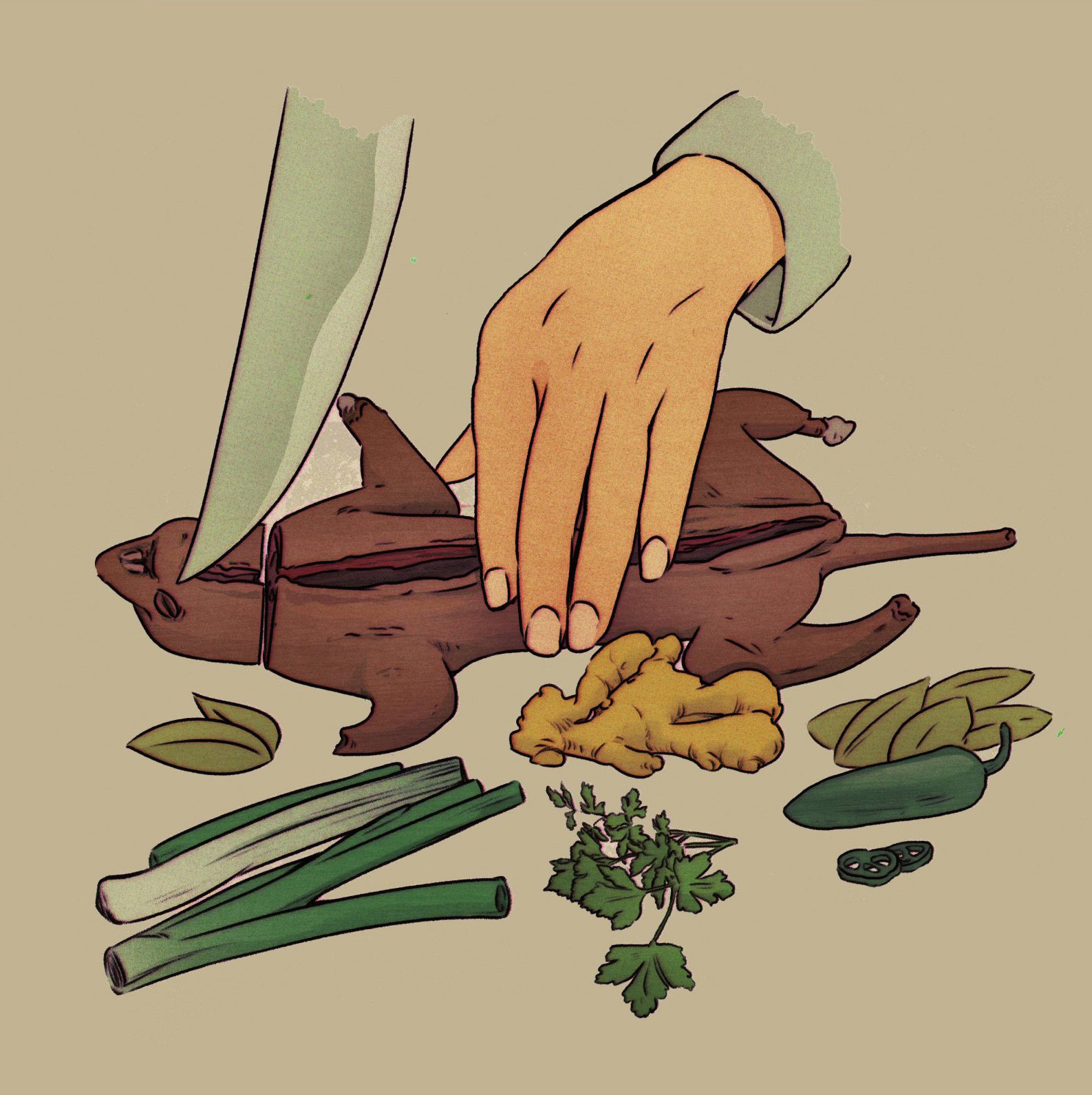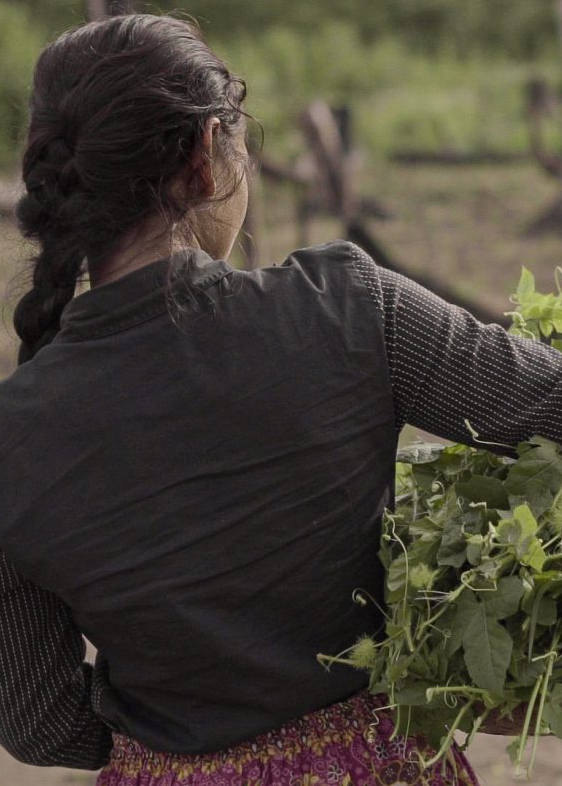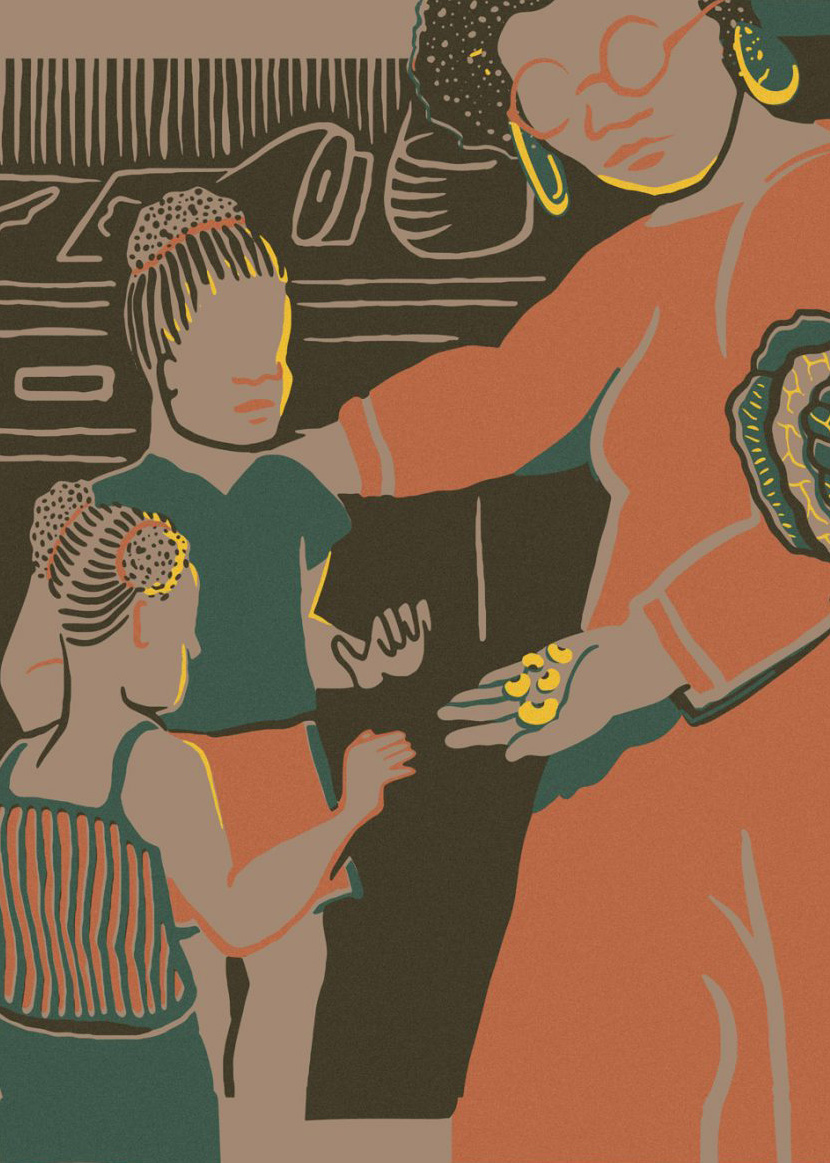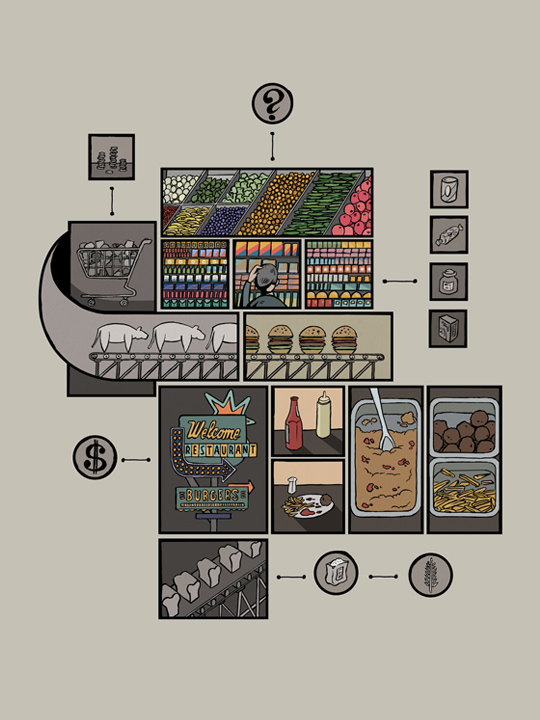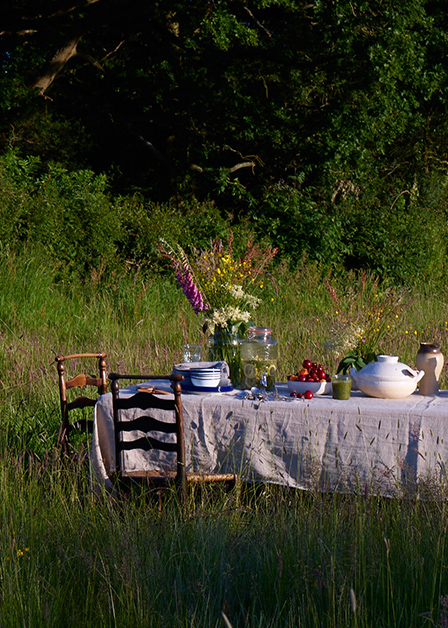

Goussy, Evan, and Isan harvest potatoes during the July konbit.
Photo by Chelsea Steinauer-Scudder
The Seeds of Ancestors
A Day at Soul Fire Farm
A Day at Soul Fire Farm
Chelsea Steinauer-Scudder is a writer based in northern New England whose work explores the human relationship to place. Her essays have been featured in Crannóg Magazine, Inhabiting the Anthropocene, and EcoTheo Review. Her forthcoming book is Rebirth: Mothering Through Ecological Collapse.
Leah Penniman is a Black Kreyol farmer and food justice activist. This profile explores her work to create spaces for people of color to heal and reconnect to the land—an effort to end America’s food apartheid system.
For thirteen years, Leah Penniman has planted and harvested food on a section of land located on the forested slopes of the Taconic range in upstate New York, forty minutes east of Albany. She calls this place Soul Fire Farm. “We have the blessing to be stewarding eighty acres of Stockbridge-Munsee Mohican territory in the rocky hills of Grafton.” The Mohican people were the original stewards of this land, forcibly relocated to Wisconsin in the 1800s.
By nine o’clock on a morning in late July, the sun is already high and the day hot. Visitors are arriving at the farm and congregating in the shade of a large tent: they carry water bottles and sunscreen and wear eager, tentative expressions that say they are here for the first time. Today is a community farm day, called a konbit after the traditional Haitian practice of voluntary, shared labor, in which farmers take turns attending and hosting work parties on their land. Once a month from April to October, Soul Fire Farm extends an open invitation to anyone who wants to lend a hand, regardless of farm experience—or ethnic background.
“Every age, ethnicity, and creed is welcome at some of our programs, not at all of them,” says Leah, who wears large teardrop earrings wound with patterned fabric and long hair plaited into a single braid, wrapped into a tower atop her head. “We have select programs that are designed for certain constituencies—for example, Black farmers, Indigenous farmers, Spanish-speaking farmers.”
Leah, as a Black Kreyol farmer in a country where 98 percent of arable land is under white ownership, politely informs those who do not identify as one of these constituencies—whether they be community members, potential funders, or members of the media, such as myself—that they are warmly invited on specified days, and not always on others. “This food system, built on stolen land and exploited labor, continues to disproportionately harm communities of color…. It’s very important to make sure that there are spaces for all of us.”
Leah’s fourteen-year-old son, Emet, checks guests in at a table fitted with a large cooler of water and a stack of release forms. Behind him, pink, yellow, and purple flowers, planted in an unmowed cluster on the lawn by the farmhouse, sway on long stems. Dozens of tomato plants are climbing inside the wide greenhouse. Rows upon rows of crops extend back over the fields, toward the deep green of the woods: the majority of these eighty acres have been kept as forest. Of the cultivated areas, roughly three acres are used for growing food and several acres are dedicated to the chickens.
Noah McDonald, this season’s farm apprentice, walks the first group of konbit volunteers from the tent to the East Field for the morning’s first task: digging Irish potatoes. He asks if anyone has harvested potatoes before; heads shake no. He grabs a pitchfork. “Let’s take a look at this plant,” he says. He demonstrates how to insert the fork into the ground a few inches from the base of the stem and then pushes down on the handle. Reaching into the loosened soil, his hand disappears and then emerges with a red potato the size of his palm.
“Oh my God,” one woman says, “it’s like treasure.”
“This food system, built on stolen land and exploited labor, continues to disproportionately harm communities of color.”
In July 2005, Leah and her husband, Jonah Vitale-Wolff, moved into a previously abandoned house on Grand Street in Albany. “It was a squat, [and] we had three families working to renovate it and eventually purchase it together,” she says.
With Leah employed as a science teacher in Albany’s public schools and Jonah working as a natural builder, they were trying to make ends meet while raising a young family: their daughter, Neshima, was a toddler, and their son, Emet, only two weeks old. As they began to get to know their new neighborhood, Leah and Jonah were troubled to find that there was no local grocery store where they could buy whole foods and fresh produce for their family. Though they both had farming experience, they found few options for growing their own fresh fruits and vegetables. “We didn’t have land to farm, a community garden plot, any type of access to grocery stores, or a car, or public transportation,” says Leah.
Grand Street is located in Albany’s South End neighborhood, classified by the federal government as a food desert—“regions of the country [that] often feature large proportions of households with low incomes, inadequate access to transportation, and a limited number of food retailers providing fresh produce and healthy groceries for affordable prices.”1
Though they could scarcely afford it, Leah and Jonah joined the Denison Farm CSA. To receive their weekly box of fresh vegetables, they had to walk over two miles each way to the pickup point. Even though the share was far more than they could comfortably afford, they were relieved to have an avenue to healthy food. But they looked around at their neighbors and community: “We didn’t want to just be enjoying this food on our own,” says Leah.
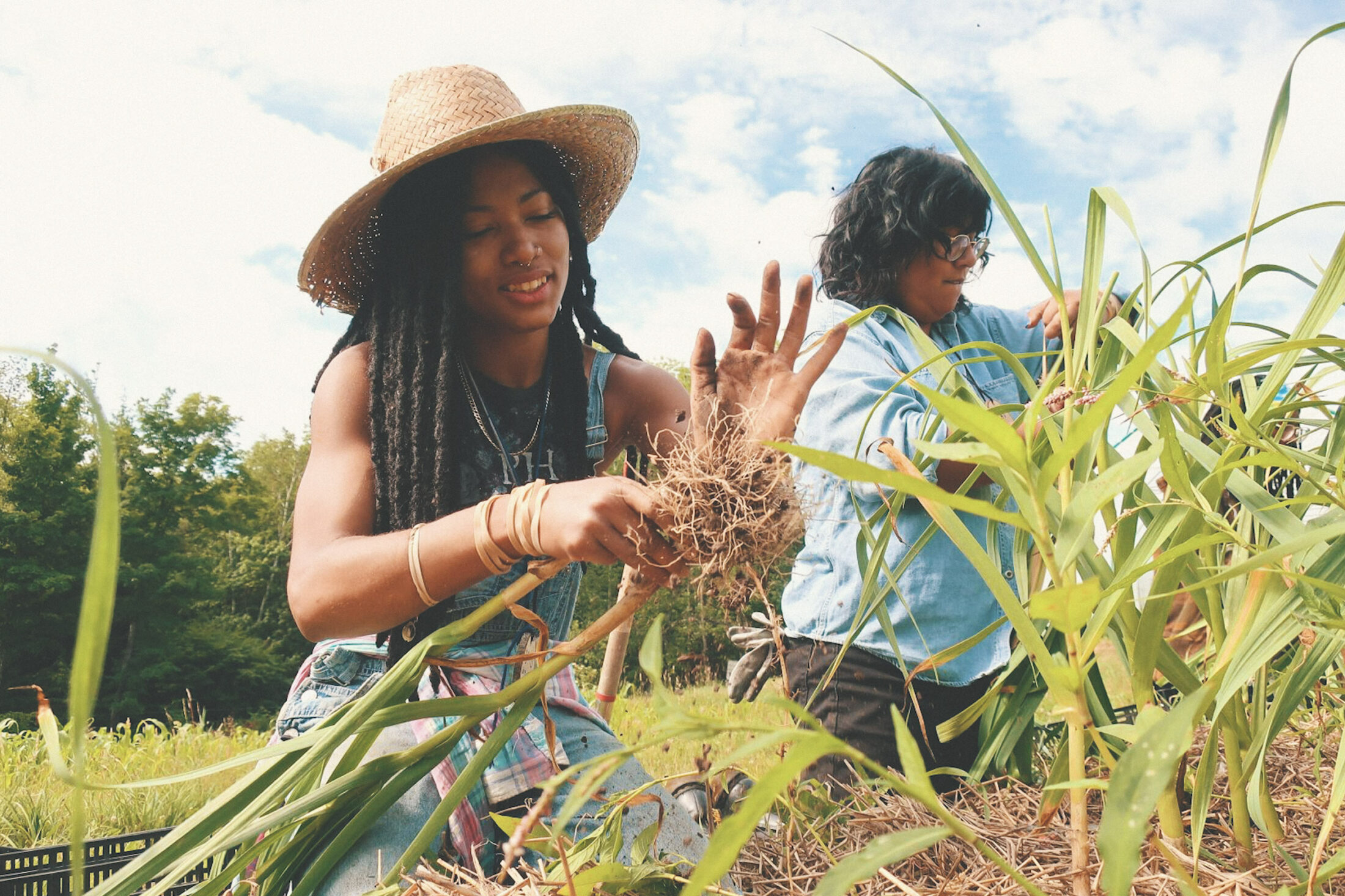

Photos courtesy of Soul Fire Farm
As more individuals and families arrive for the konbit and a cloudless sky urges the day toward sweltering, the adults settle quickly into the work while the younger children decidedly opt for curiosity over diligence. A stream of questions and exclamations—“There’s that old rooster crow again!”—accompany the soft thud of potatoes being placed into large crates.
Once the potatoes have been harvested and loaded into the bed of a pickup truck, the group relocates to pull pigweed out of the carrot patch.
Goussy has come from Queens with her sons Evan and Isan, nine and six. She smiles and shakes her head at her boys, who are “weeding with a flourish”—yanking up interlopers and flinging them toward the woods. Both of Goussy’s parents are from Haiti, where her grandfather owned a farm and konbits were a frequent occurrence. It’s an experience she and her husband want their children to have. But from their home in New York City, she says, it’s easy to feel apart from the natural world.
“It’s important for my kids to know where food comes from—to not have a disconnection or to think that everything we eat comes from the store.” As noon approaches and her water bottles are nearing empty, Goussy wraps an arm around Evan’s shoulder. “Come on,” she says, “let’s take a break.”
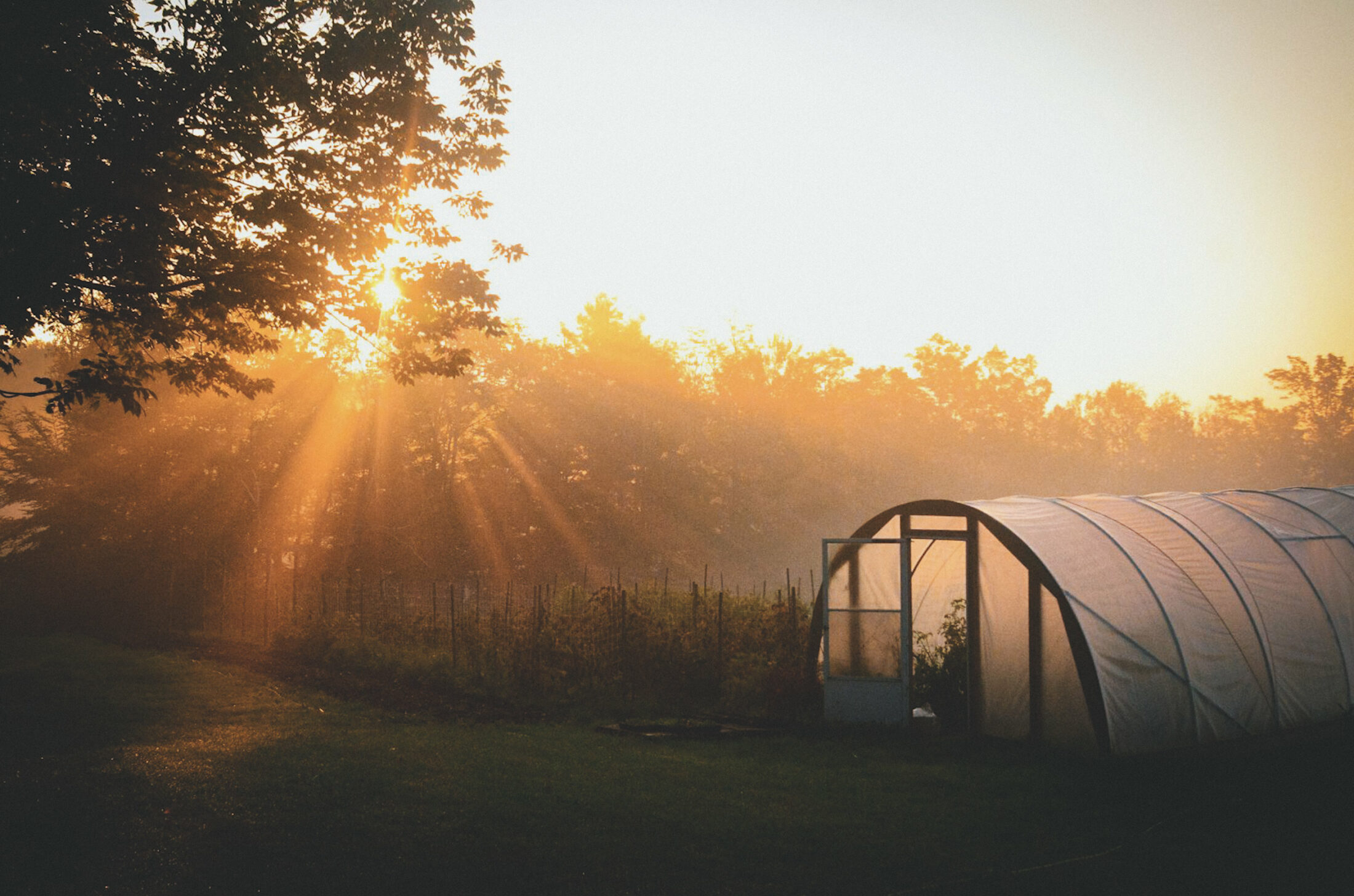
Photo courtesy of Soul Fire Farm
Leah’s grandmother, Brownie McCulloh, had a strawberry, flower, and apple garden outside of Boston. “I went and picked strawberries with her and made jam with her, and my most beloved type of farming that I do now is perennial agriculture—specifically strawberries.”
Growing up, it was not unusual for Leah and her siblings to go to bed hungry. Raised in a trailer home in rural Massachusetts, where they were bullied at school as mixed-race children in a majority-white community, Leah and her sister spent a lot of time in the woods behind their home. “My sister Naima and I created what we thought was our own religion as small children—we would go into the woods and make shrines for Mother Nature, light candles, make offerings.”
“The woods was a safe place for me, whether it was light or dark. I would go into the woods in the middle of the night with no flashlight and just feel my way through … I had a game that I played where I would follow the little dappled spots of sunlight, one to the next, and that would be my map through the forest. It was where I felt whole.”
Her intuitive relationship with the natural world became more complicated as Leah grew into a teenager. She was struggling to reconcile her desire to be outdoors with her Black identity and the “bombardment of messages that our only place of belonging on land is as slaves, performing dangerous and backbreaking menial labor.”2 The examples she saw of fighting racism and injustice were focused on gun violence or education reform, not on reclaiming a relationship with the land.
In 1996, at age sixteen, she got a summer job at Boston’s Food Project growing food for urban neighborhoods, and began to learn how to plant and harvest with her own hands. She “was hooked.” But as she deepened her knowledge and experience as a grower—at the Farm School, Many Hands Organic Farm, Youth Grow, and by working with farmers in Haiti, Mexico, and Ghana—she saw few people of color within the worlds of organic farming and environmental activism in the United States. She worried that bending her back to the soil was still somehow a betrayal of her enslaved ancestors.
Her ancestry was something she had limited information about: at the time, parts of her family’s origins could only be traced back to the Carolinas. The thread that held the record of her mother’s family lineage had largely been severed.
It was in Ghana—where Leah worked with farmers in Manya Krobo—that she learned how to engage marginalized members of society through agricultural projects that helped them earn an income. While there, she was taught by the Manye, or Queen Mothers—the female leaders charged with maintaining the ethical and spiritual integrity of their communities. “They’re the conflict mediators; they do all of the storytelling for the whole community; they raise the orphans; they run a boutique business; they’ll do your wedding, your funeral,” says Leah.3 Under the tutelage of the Manye, Leah witnessed and participated in Vodun, an ancient Indigenous religion which venerates the ancestral spirits, who are believed to inhabit the Earth.
Though she was learning this tradition for the first time, it felt deeply familiar. One night, Leah dreamt that she was planting maize on Krobo Mountain,4 the home of the Krobo people who are indigenous to Ghana and are known as a farming people. The Krobo priest who interpreted her dream told her that only people of that community were allowed to plant maize on that mountain, their ancestral homeland.
“It was literally when I went to Ghana … and saw people worshipping as adults and as a community in the way that [my sister and I] were worshipping as children, that I inferred a resonance rather than an invention…. I realized that [my childhood experience] had been more of a remembering.”
Later, after she had returned to the US, Leah sent in a swab from her cheek for a DNA test. The results showed that her mother’s ancestry traces back to Ghana.
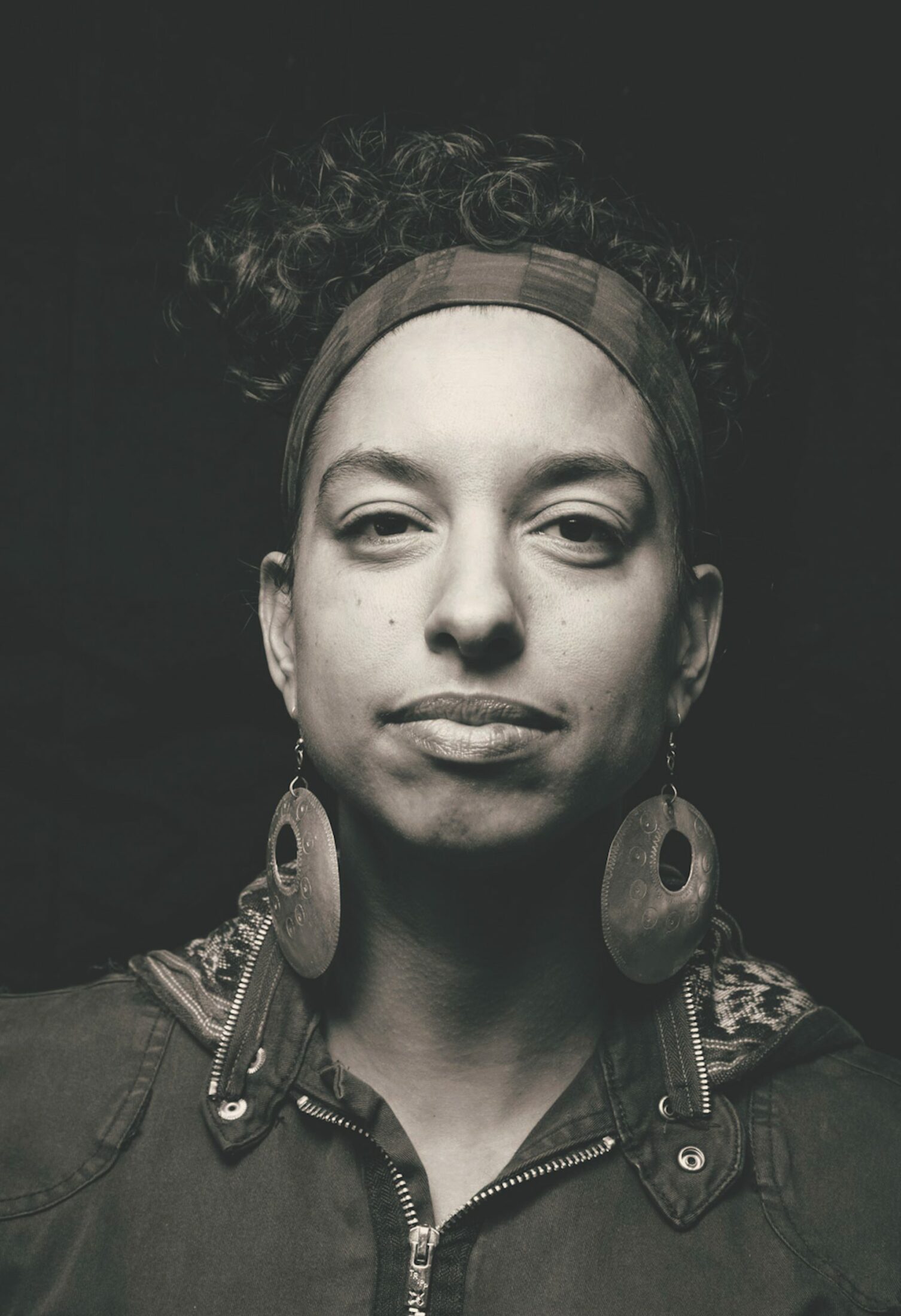
Photo of Leah Penniman
by Rush Jagoe, Courtesy of Soul Fire Farm
“Like our ancestors before us, across the African Diaspora, we really believe that the Earth is not simply a commodity.”
Attending today’s konbit marks Dennel Marrow’s first time on a farm as an adult. Seated on the ground alongside the carrot patch, the twenty-nine-year-old has just learned how to carefully pull weeds out from among the tender green tops of carrots. One by one, he carefully removes the long invasive roots without dislodging the young crop from the soil.
“I’m here because I want to take control of my own legacy,” he says. “My family has never had control of their food.” Multiple members of Dennel’s family have died from diabetes and heart disease. “I care about my body, my self, my health. I want to switch this shit up. If I have kids, I want us to grow our own food, take the reins.”
Minority communities are twice as likely as white communities to live within the borders of a food desert. Leah prefers the term food apartheid. “A desert is a natural ecosystem,” she says. “There is nothing natural about people lacking access to healthy, affordable food.” Racial segregation remains endemic in our political, social, and agricultural systems—it did not end with the Emanicpation Proclamation, nor with Civil Rights.
After the Civil War, the prospect of freed slaves owning and farming their own land posed a severe threat—economically and existentially—to whites in the South, who had just lost their entire labor force. Systemic efforts to undermine Black freedom were quickly established. The Thirteenth Amendment, ratified in 1865, states: “Neither slavery nor involuntary servitude, except as a punishment for crime whereof the party shall have been duly convicted, shall exist within the United States.” Building from this exception within the amendment, Black Codes were promptly written into state law across the South within the year, outlawing acts such as vagrancy, which was “so vaguely defined … that virtually any freed slave not under the protection of a white man could be arrested for the crime.”5 States then began a system of convict leasing, in which Black men convicted under such laws were then sold back to plantations as forced, unpaid labor.
Under the sharecropping system, equally widespread at the time, white landowners leased land to Black (and white) farmers in exchange for a share of the yield. But many landlords used tactics, such as fixing the scales used to weigh crops to be in their favor or leasing equipment and tools at exorbitant rates, to keep tenants enslaved by debt and bound to the plantations.
Despite Black Codes, sharecropping, rampant racial terror, and countless other means by which the liberty of freedmen was systematically and ruthlessly undermined, a sizeable number of acres were purchased by Black families in the decades following Reconstruction—a testament to the determination of Black families to own the land under their feet and pass it on to their descendents. In her book Farming While Black, Leah cites that by 1910, at the height of Black land ownership in the United States, sixteen million acres of farmland—14 percent of America’s total—was owned and cultivated by Black families.
But it was not to last long. In his recent article for The Atlantic, “The Great Land Robbery,” Vann R. Newkirk II traces Black land ownership and the ensuing land dispossession from Emancipation through the present day. The majority of Black families—especially in the fertile South—who finally did acquire land on which to farm and make a living, saw almost all of it taken back. As he writes: “Thousands of individual decisions by white people, enabled or motivated by greed, racism, existing laws, and market forces, all pushed in a single direction.”
Fannie Lou Hamer, who would later become a civil rights activist, was born on a farm in Mississippi in 1917. When she was a teenager, her family had finally saved enough money to purchase three mules, and her father was able to buy a car and had begun fixing up their house. Then a white neighbor poisoned their livestock with insecticide, killing them all. “We never did get back up again,” she said of her family.6 Families were chased from their homes, saw their homes burned down, were murdered and terrorized. Between 1877 and 1950, over four thousand racial terror lynchings occurred in the South.
Once Black farmers owned land, they needed loans to maintain it, but the USDA and the Federal Housing Administration routinely refused to offer them lines of credit that were annually given to white farmers. During the 1960s, if a Black landowner was known to be a member of the NAACP, involved in civil rights activism, or registered to vote, his or her loan application was all the more likely to be denied. This practice left farmers unable to maintain their land and has continued into the present day: for example, in the 1999 Pigford v. Glickman case, a class action discrimination suit between the USDA and Black farmers, in which tens of thousands of farmers were ultimately awarded more than $2 billion over two settlements; and in the 2018 case Provost v. First Guaranty Bank, a civil rights suit filed in Louisiana alleging lending discrimination against a Black sugar cane farmer.
From 1910 onwards, Black farmers lost 90 percent of the land they had come to own. From 1916 to 1970, six million Black people fled the South during the Great Migration. Leah’s family was among them. “My family went to Pittsburgh to work in the factories and left behind their farm in Rockhill, South Carolina, hoping for something better for their children and hoping to survive.”7 Today, less than 1 percent of arable land is owned by Black people, constituting a loss of twelve million acres, the majority of which are back in the hands of white landowners.
Dispossession of property was not confined to the South, nor to farmable land. After the Second World War, two New Deal agencies, the Federal Housing Administration and the Home Owners’ Loan Corporation, fostered the practice of redlining, which designated minority neighborhoods as “risky” for loans and mortgages. As Ta-Nehisi Coates outlines in “The Case for Reparations” in The Atlantic, “Across the country, whites looking to achieve the American dream could rely on a legitimate credit system backed by the government. Blacks were herded into the sights of unscrupulous lenders who took them for money and for sport.” He goes on to say that, in America, “the concentration of poverty has been paired with a concentration of melanin. The resulting conflagration has been devastating.”
Today, one in three Black children rely on food banks and other forms of emergency food to reach their daily caloric intake. Food injustice and food apartheid, explains Leah—experienced by her own family and by families like Dennel’s—is not a natural consequence of a broken system but a direct result of a functioning racist system that has left a legacy of historical and ongoing segregation around access to land and food.

Photo courtesy of Soul Fire Farm
“When our community [in Albany] realized we knew how to farm, and we realized in turn how difficult it was for community folks to access food, the idea of Soul Fire came about,” says Leah. “We got very, very motivated to figure out a way to find land and to grow food.”
In 2006, Leah and Jonah scraped together their savings and purchased the marginal land that would become Soul Fire Farm: seventy-two acres (they’ve since acquired eight more) in the Upper Hudson Valley consisting of overgrazed pastures and thin, rocky soil over hardpan clay—land that their agricultural neighbors told them was not at all well-suited for growing food.
As Jonah constructed passive solar buildings, Leah set to work on the soil, which had been severely depleted, containing, at the time, only 3 percent organic matter. Following no-till Afro-Indigenous technologies and agroforestry practices, Leah—with help from family and community—began to regenerate the land. Following the Haitian agroforestry model of jaden lakou, or courtyard gardens, they planted hedges, fruit trees, and herbs between the forest and the fields as a way of weaving the interconnected ecosystem of the woods into the cultivated acres. Guided by the Kenyan method of fanya-juu, they carried the topsoil—shovelful by shovelful—that had run off the hillsides into the areas that became the terraced growing fields.
They installed raised garden beds—in the way of the Ovambo people in Namibia—and a composting system. (Composting was so valued by Cleopatra, recounts Leah, that she made a law that anyone who killed a worm would be put to death.) Soul Fire Farm’s transplanting practice is based on the knowledge of Mende rice farmers in Sierra Leone. They implemented leguminous cover-cropping, planted heirloom seeds, and began to graze chickens. Ultimately, they built up eighteen inches of topsoil that has 12 percent organic matter. “To us, that number symbolizes the re-indigenizing of the soil,” says Leah. “It’s like calling the carbon, calling the life, back into the land, out of the atmosphere where it’s doing harm, back into the land where it produces food and supports the ecosystem.”
Leah does not see a distinction between her spirituality and her stewardship of the land. While in Ghana, she had been initiated and enstooled as a Queen Mother by the Manye and directed to come to America to serve in the Diaspora. She has continued her spiritual learning through Haitian Vodou, which stems from Vodun, and through the Yoruba Ifá tradition of Nigeria. “Like our ancestors before us, across the African Diaspora, we really believe that the Earth is not simply a commodity, a natural resource, or the environment in which we live, but the Earth, whose other name is Ile Ayé in Yoruba, is a divine being, a spirit.”
When she wanted to dig out a pond behind the house, Leah used Yoruba Ifá divination to ask the land for permission. The land replied with a “firm no.” She waited, and waited. It took ten years for the land to approve the pond. During this time, she came to understand that she needed to be making offerings to Nana Buruku, a spirit of forest waters, and put in the proper safety measures around the water to protect children.
“We are obligated to provide respect, provide offerings for Ile Ayé, and to ask consent for our activities. And what that means in the spiritual realm is making offerings of tobacco and cornmeal and rum and water and flowers, dancing, singing, having festivals, using divination tools to ask permission to do major changes. The physical dimension of this is it gives pause enough to consider whether an ecosystem modification is going to be in right relationship with all the beings on the land. So before cutting down trees, we are thinking about, well, how is that equivalent amount of carbon going to be captured elsewhere so that the whole ecosystem remains in balance?”
After five years, the farm had its first full harvest in 2011. Heirloom vegetables filled the boxes of the Ujaama Farm Share, a sliding scale CSA. That season and for each season since, the farm share has provided fresh produce to Leah and Jonah’s former South End neighbors in Albany, and to others in the Albany-Troy-Schenectady communities who are in need of fresh food. Recipients pay what they are able, even if this means nothing at all, and can use Supplemental Nutrition Assistance Program (SNAP) benefits. The Solidarity Shares Program of the CSA provides a free share to anyone who is a refugee or who has returned to the community from prison.
“Every single week,” says Leah, “we are boxing up vegetables, pasture-raised chicken, eggs, herbal medicine, value-added products, and bringing it to people’s doorsteps.”8 Over 95 families—350 individuals—receive the farm share.
“A desert is a natural ecosystem. There is nothing natural about people lacking access to healthy, affordable food.”
As the konbit volunteers convene for a potluck lunch, Leah disappears into the barn, carrying a large bundle. She emerges and pauses for a long, quiet moment to embrace Jonah and Neshima before striding quickly into the house. She organizes a group activity on gratitude before we eat, then meets and chats with the dozen people who approach her to introduce themselves. When she finally sits down, she speaks to an elderly woman in Spanish, then asks the man across the table his method for making the chaga mint tea.
With the CSA up and running, Soul Fire Farm expanded its operations to be not only a fully functioning farm, but a place of teaching and activism for both aspiring farmers and community members. They are engaged in an active reparations project, matching farmers of color to donors who can give land and resources. They run weeklong BIPOC-FIRE trainings (Black, Indigenous, and People of Color Farming in Relationship to Earth), Spanish immersions, public talks, Uprooting Racism programs, konbits, and programs for youth. Participants learn the practical techniques of Indigenous farming, but they are also offered space to dance, sing, grieve, share stories, and openly discuss historical and ongoing trauma.
The land of Soul Fire Farm is now owned by a housing co-op, under which the land has a voice as a voting member, with veto power. The co-op, in turn, is part of the forthcoming Northeast Farmers of Color Land Trust, which aims to create an agrarian commons for Black and Indigenous people.
Leah currently works as Program Director: teaching, organizing, speaking, traveling, and writing. In 2019, Soul Fire’s programs served ten thousand people. “In 2020, I’m actually going to resume the role of Farm Manager, which I’m really excited about,” says Leah. “I have been yearning to touch the land again and … making sure that most of my work hours are listening to the land, are listening to the plants and the animals, and that less of my work hours are responding to human speech … I think that I have to give myself permission to just be in the forest now, to follow spots of sunlight. I don’t often allow myself time or permission to do that.”
Leah’s grandmother’s grandmother’s grandmother was given the enslaved name Susie Boyd. “Her true name was lost to the seas of time.” She was kidnapped from Dahomey, West Africa, in the late 1700s.9
“She made this really audacious and courageous decision,” says Leah, “to gather up the okra, the millet, the black rice, the molokhia, the sorghum, and braid it into her hair. And braid it into her children’s hair. Because they knew that wherever they were going, they believed that there would be a future of tilling and reaping on soil and there would be some seed that we all needed to inherit. That’s what our grandmothers did for us … They didn’t give up on us.”10
After lunch, while some chat and mingle near the farmhouse, Leah leads a group on a tour of the farm, the last activity of the day. She pauses at the chicken coop and recounts the mysterious arrival of Apollo Creed, the white rooster that one day appeared at the edge of the woods and chased away Rocky Balboa, the unpopular rooster that had been fond of attacking anyone who came near the coop. At the cornfield, she tells the story of Sky Woman and how the original Mohican stewards of the land learned to plant corn, beans, and squash together. She invokes Harriet Tubman’s skills as an herbalist; George Washington Carver’s advances in legume science; Booker T. Whatley, one of the founders of community-supported agriculture; the first community land trusts; Fannie Lou Hamer, who went on to become a civil rights leader and women’s rights activist.
“We didn’t invent any of this,” she says.
At the end of the tour, a weary but smiling group, with sweat running in tiny rivers over mud-caked arms and hands, stands in a semicircle around an unruly patch of flowers and greens. “I’ve brought you to my favorite place,” Leah says. “This is the perennial garden.” The plants that return year after year in this corner of the farm are used to create tinctures, salves, medicines, and remedies. On special days and for specific programs, Leah will harvest from the perennial garden to give herbal baths for spiritual healing.
Leah thanks everyone for coming, and the group disperses, soon to be heading home to New York City, Montreal, Washington State.
“Just about everyone who comes and touches this land and is part of this community is transformed and takes the seeds that we believe we’ve picked up from our ancestral grandmothers, who braided them in their hair before being forced on transatlantic slave ships,” says Leah. “We’ve picked them up and passed them on, and folks take them and go and plant them.”
- Paula Dutko, Michele Ver Ploeg, and Tracey Farrigan, Characteristics and Influential Factors of Food Deserts, ERR-140, US Department of Agriculture, Economic Research Service, August 2012.
- Leah Penniman, Farming While Black (Chelsea Green Publishing: Hartford, 2018), 3.
- From a lecture by Leah Penniman, “Farming While Black: African Diasporic Wisdom for Farming and Food Justice,” at Harvard Divinity School Center for the Study of World Religions, September 17, 2019.
- Tracy Frisch, “To Free Ourselves, We Must Feed Ourselves: Leah Penniman on Bringing People of Color Back to the Land,” The Sun, July 2019.
- Douglas A. Blackmon, Slavery by Another Name (New York: Doubleday, 2008), 53.
- Reporting Civil Rights Vol. 2, ed. Clayborne Carson (New York: Library of America, 2003), p. 100.
- Penniman, lecture, September 17, 2019.
- Ibid.
- Ibid.
- Ibid.
